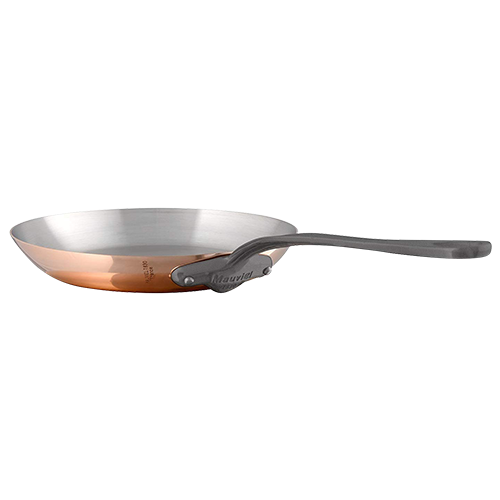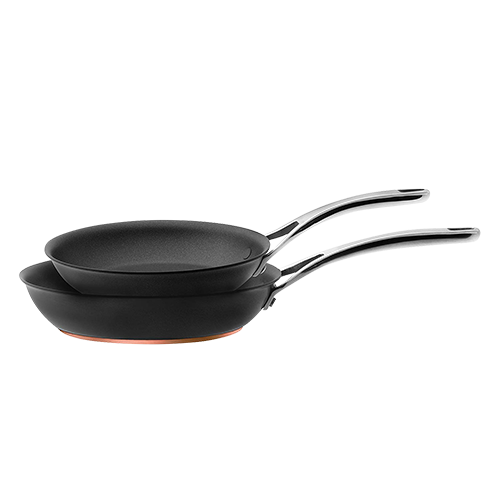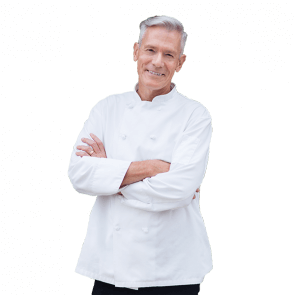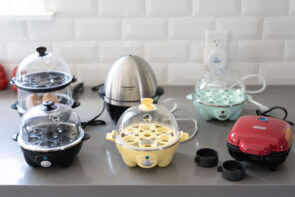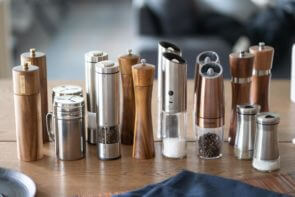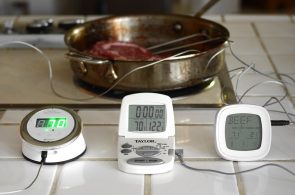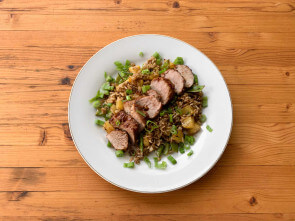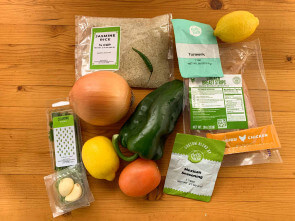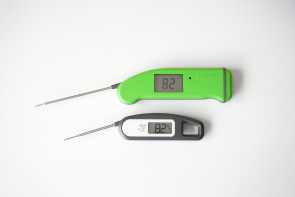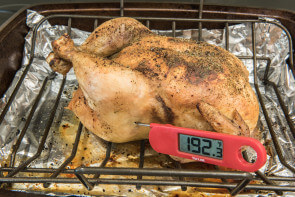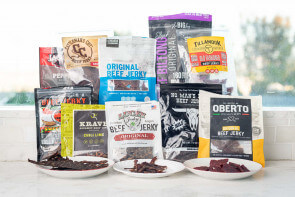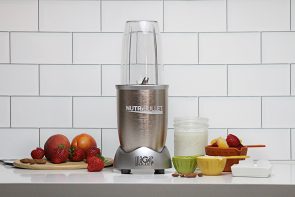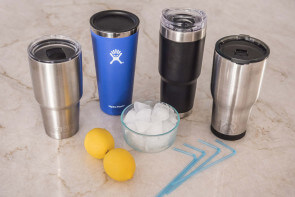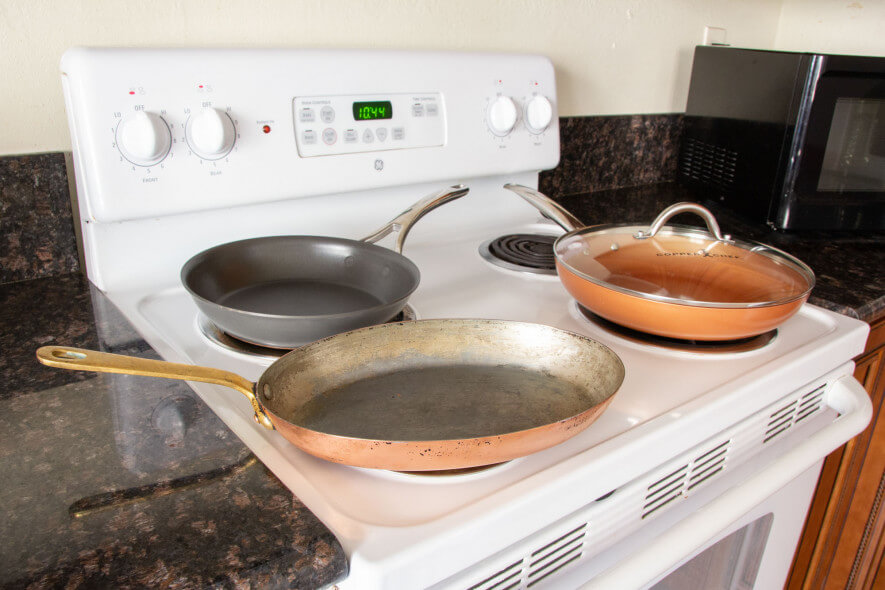
The Best Copper Cookware
We compared how authentic copper cookware cooked to the Anolon – Nouvelle Copper copper-core cookware and the popular Copper Chef, ceramic-coated cookware that’s purportedly copper-infused. The copper pan had a slight edge over the nonstick Anolon, which cooked food almost as evenly and quickly. The Copper Chef, however, is made of cheap, lightweight aluminum and didn’t have copper’s heat conductivity or distribution.
We compared how authentic copper cookware cooked to the Anolon – Nouvelle Copper copper-core cookware and the popular Copper Chef, ceramic-coated cookware that’s purportedly copper-infused. The copper pan had a slight edge over the nonstick Anolon, which cooked food almost as evenly and quickly. The Copper Chef, however, is made of cheap, lightweight aluminum and didn’t have copper’s heat conductivity or distribution.
Table of contents
- Benefits of copper cookware
- Important features to consider
- Alternatives to copper cookware
- How we tested
- Best copper cookware: 100% copper
- Best copper-core cookware: Anolon – Nouvelle Copper
- Copper-infused ceramic-coated: Copper Chef
- The bottom line
Benefits of copper cookware
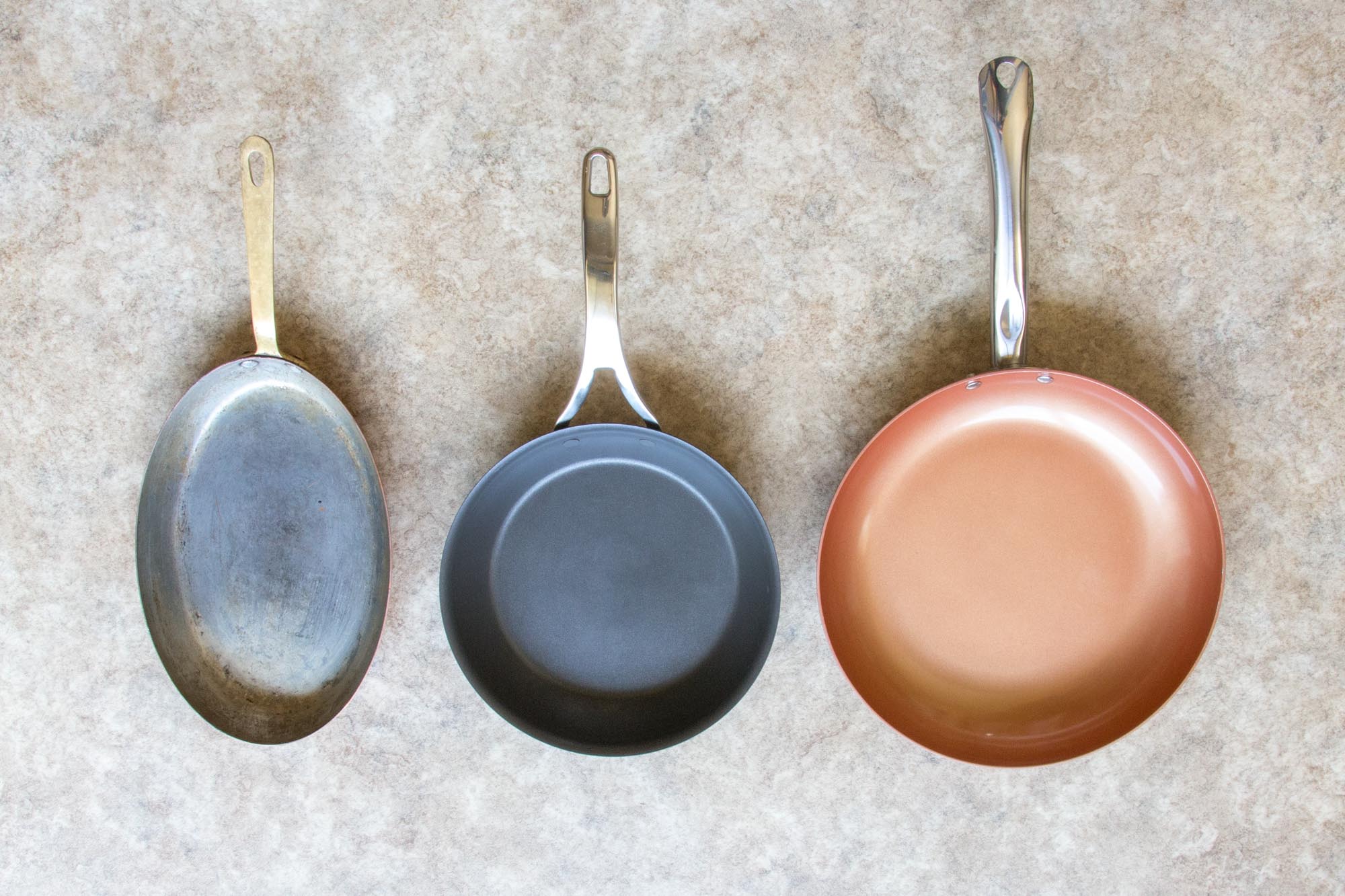
Copper cookware is arguably the type of cookware most cherished by professional chefs and skilled home cooks.
Julia Child firmly believed that every serious-minded cook should own at least one copper pot or pan. She discovered the benefits of cooking with copper during her years in France, where she purchased the thirty copper pots and pans now on display at the Smithsonian Institute in Washington, D.C. Julia cooked with those beloved pots for 45 years on all of her television programs, because copper allows for the precision that French cookery requires.
Centuries before Julia filmed her first episode of The French Chef, the ancient Romans discovered that copper heats faster and more evenly than other metals, because of copper’s heat and electrical conductivity, which is second only to silver. Copper also cools very quickly, so once the copper pan is removed from the heat source, its temperature rapidly drops, which helps prevent a delicate sauce from overcooking or separating.
Important features to consider
Copper is highly reactive: A reactive metal like copper conducts heat very efficiently, but it also reacts with acidic foods. Tomatoes, vinegar and lemon can absorb not only a metallic flavoring but the metal itself.
Copper pots and pans are lined with nonreactive metal: Copper cookware has been traditionally lined with nonreactive tin, which is not affected by acidic foods. With extended use over many years, tin does darken and wear away, so a tin-lined copper pan needs to be eventually re-tinned, or copper will leach into food, which our bodies can’t process and eliminate.
In recent years, copper pots and pans have been lined with stainless steel. Stainless steel, of course, is a hard, durable metal, but it lacks tin’s conductivity. Stainless liners are often coated with a nonstick material like PTFE (Teflon is the name brand), which, as we discussed in our reviews of nonstick pans and nonstick cookware, can be hazardous if the pan gets too hot.
Tin, on the other hand, is naturally nonstick and has low toxicity. For copper cookware, it’s the preferred metal for lining.
Copper cookware can’t be used for all cooking methods: Tin has a melting point of 450° F, so a tin-lined copper pan should never be used for high-heat searing. For steaks, burgers and other foods you want browned, use a cast-iron pan instead. Copper is best for low-heat cooking, such as sauces, seafood, omelettes and other egg dishes.
Copper pots are expensive: A copper saucepan from such well-known manufacturers as Mauviel and Falk runs about $450, and an entire cookware set can be as high as $2,000.
However, vintage pieces are available online. We purchased an authentic omelette pan, made in France, on Ebay for $40. Though vintage copper cookware will probably need polishing and retinning, it is much more affordable than buying copper cookware brand new.
Alternatives to copper cookware
Copper-core
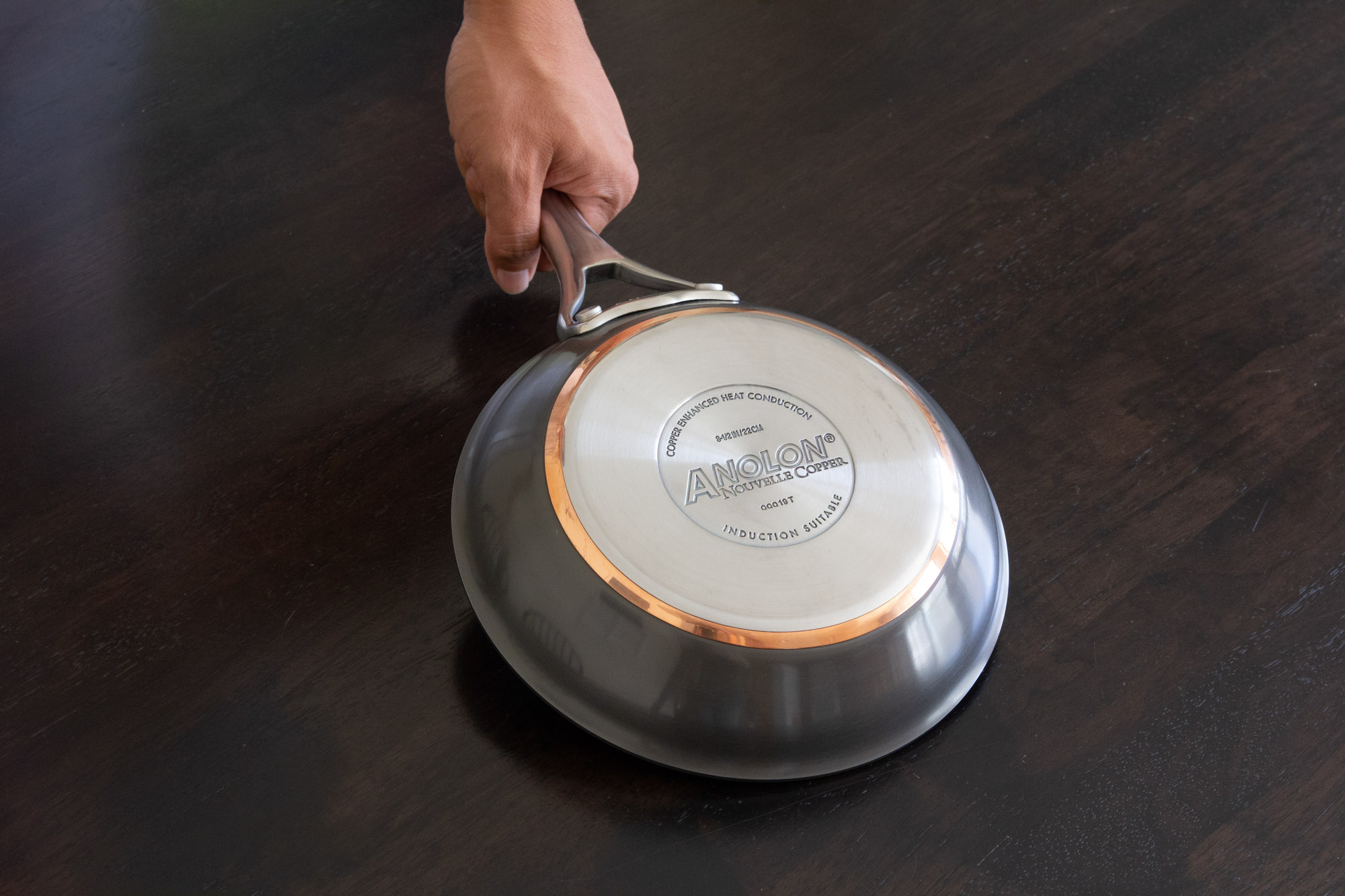
Copper-core cookware is made primarily from more common metals, with a four- or five-layer base composed of a thin layer of copper sandwiched between layers of aluminum and/or stainless steel. The copper-core cookware that is made primarily of stainless steel is approximately triple the price of aluminum cookware.
The copper layer improves stainless steel’s heat conductivity and distribution, and the stainless steel makes the cookware more durable. Copper-core cookware also withstands higher temperatures and, because of the stainless-steel base, can be used on induction cooktops.
Copper-core cookware that is composed primarily of aluminum is considerably less expensive and usually has a non-stick surface.
Copper-infused ceramic-coated
This type of inexpensive, nonstick cookware is very popular, thanks to aggressive infomercials by two rival companies, Red Copper and Copper Chef. Their cookware is made of lightweight aluminum and is coated with a ceramic that they claim is infused with copper and can handle higher temperatures than 100% copper cookware.
Both companies market their cookware as all-purpose pans for searing, broiling, braising and frying: cooking methods that should never be used with copper.
How we tested
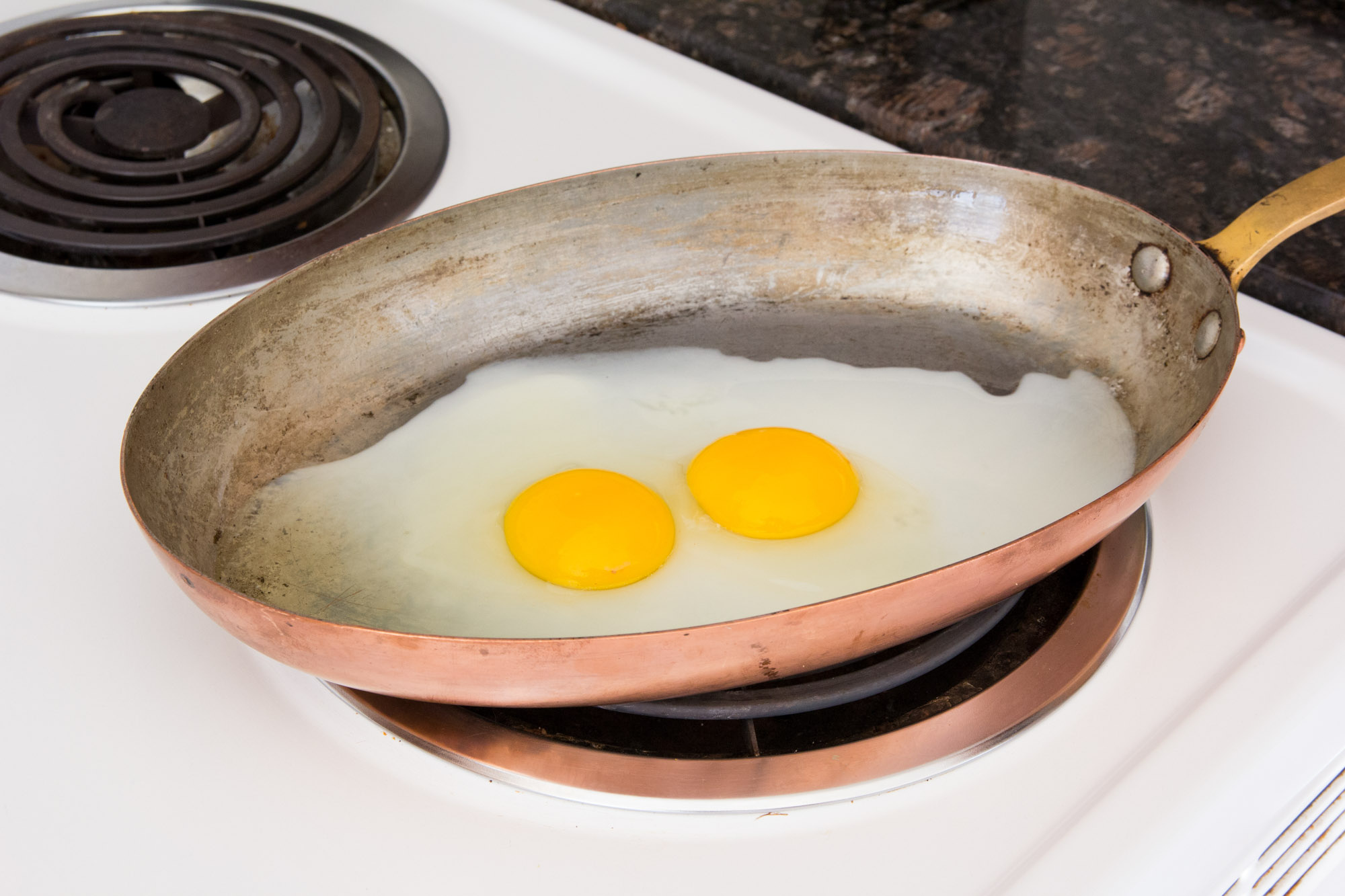
We decided to see how well a copper-core pan, Anolon – Nouvelle Copper, and a copper-infused ceramic-coated pan, Copper Chef, fared against the real thing, a vintage tin-lined copper pan that we purchased on eBay.
The oval copper pan, generally used for cooking omelettes and fish, was manufactured in France, and although we don’t know when, it was obviously a much-used pan in someone’s kitchen. Its tin lining was scratched and had darkened to a gray patina, and the copper was spotted and tarnished.
Using a home remedy of Kosher salt, vinegar and flour, we rubbed the mixture onto the copper, and its years of neglect magically wiped off. Though our pan didn’t look quite new again, it was still a pretty pan that helped us understand why people would pay a small fortune for new copper cookware.
We conducted several simple but illustrative cooking tests. We used no oil or butter, and everything was cooked at medium heat.
Fried eggs: We cracked whole eggs into the center and far edge of each pan and noted whether the center egg cooked faster than the side egg, or whether they both cooked at the same time. We also tested the pan’s nonstick capability by turning the eggs over and then scrambling the yolk and uncooked white.
Pancakes: We used a basic recipe for pancakes and poured a pancake into the center and two pancakes on either side of the pan. Similar to the egg test, we were looking for evenly cooked pancakes. When we flipped the pancakes, we noted how the pancakes had browned and if they slid out of the pan without effort.
Hamburger: We pan-fried a ⅓-pound, ¾-inch-thick hamburger made of 93% lean grass-fed organic beef. Each burger was fried for five minutes on each side. We were looking for an evenly browned and crisp exterior with a medium-rare interior.
Test results
| Category | Conductivity | Cooks Evenly | Nonstick | Overall |
|---|---|---|---|---|
| 100-percent Copper | ☆☆☆☆☆ | ☆☆☆☆☆ | ☆☆☆☆☆ | ☆☆☆☆☆ |
| Copper Core | ☆☆☆☆ | ☆☆☆☆☆ | ☆☆☆☆☆ | ☆☆☆☆☆ |
| Copper-Infused | ☆☆ | ☆☆ | ☆☆☆☆ | ☆☆ |
Best copper cookware: 100% copper
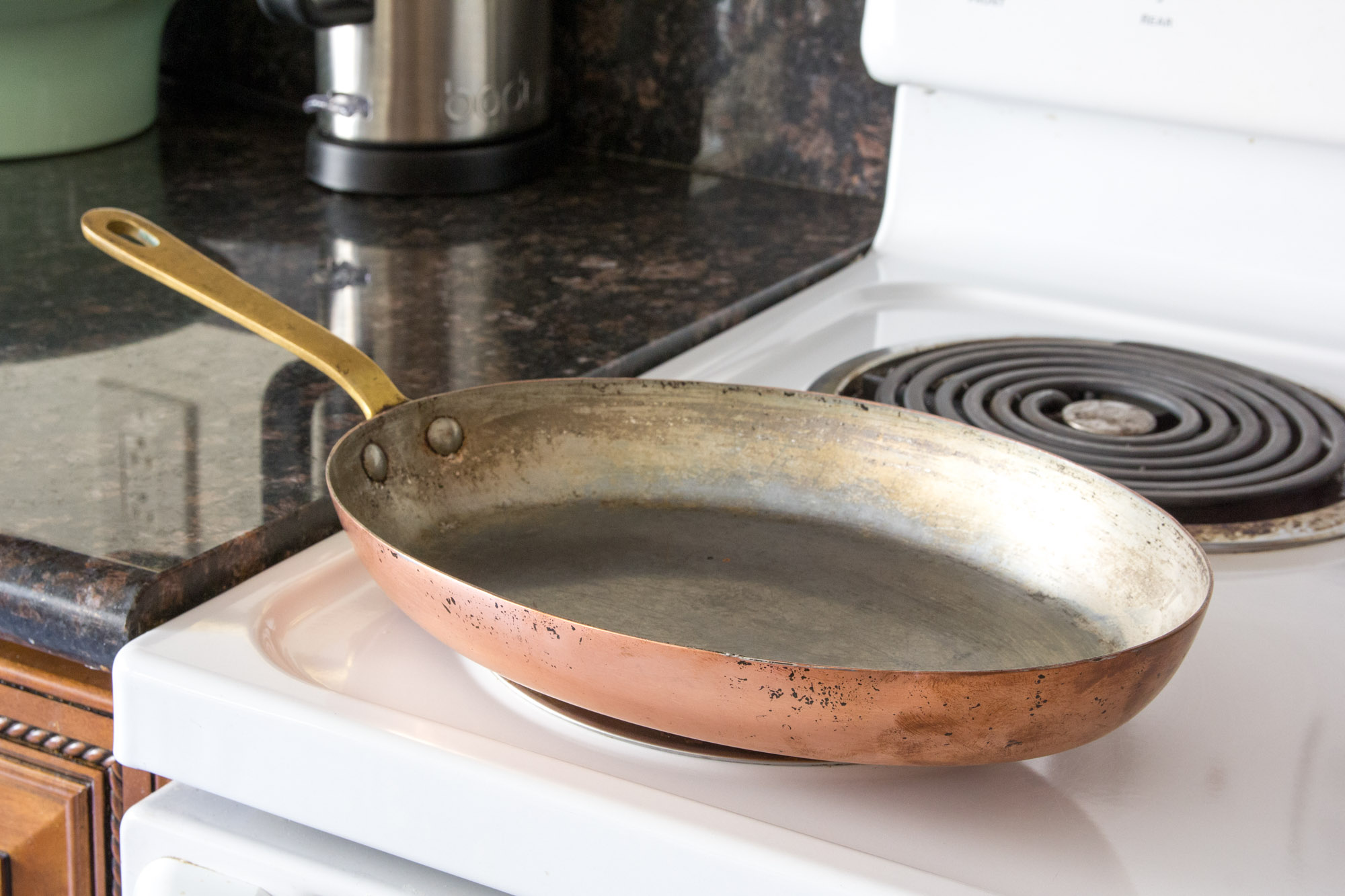
The Anolon – Nouvelle Copper was an admirable competitor, but our traditional 100% copper pan was the winner. As mentioned earlier, copper pans are famous for heat conductivity, and our vintage copper didn’t disappoint. The copper heated up quicker than the Anolon and Copper Chef, and after a couple of burnt pancakes, we turned down the heat source to medium-low, since it clearly didn’t need to be as high as the other two pans did.
Across the board, results were perfect, although the copper did require precision in controlling the heat level. Since this particular pan is intended for cooking omelettes, we poured in a couple of beaten eggs and were amazed by how rapidly it cooked and how easily the omelette could be folded and rolled. We don’t know how old our copper pan is, but it’s remarkable that its tin lining’s held up so well.
By the time we got to the hamburger, the pan was very hot, so we removed it from the cooktop and adjusted the heat. Our copper pan is oval, so its edges hang over the cooktop’s round heating element. We thought that the edges of the pan would be less hot; but we were wrong. We leaned the burger against the curved sides of the pan, and the burger cooked as well as it did in the center of the pan.
Clean-up was simple: once the pan cooled, we washed it with warm soapy water, and food residue came off with no scrubbing needed (harsh scrubbing erodes the tin lining). Copper can spot easily from water droplets, so all copper cookware must be towel-dried, and it should never be put into the dishwasher.
Copper pot and pans aren’t for everyone or for every type of food. You need to continually adjust the heat level to prevent food from overcooking or burning. But with trial and error and some basic culinary skills, you’ll soon learn to cook with copper cookware and turn out meals like a professional — and dare we say, like the French Chef herself.
Tin-lined copper cookware is hard to find brand new, but one of the best makers of copper ware is Mauviel M’heritage: it’s 90% copper with stainless-steel lining. If you want to take the financial plunge, you can purchase an entire set or individual pieces on Amazon.
Key takeaways:
- 100% copper has superb heat conductivity, so it heats up fast, and heat distribution, so food cooks evenly on all surfaces of the pan.
- Traditional copper pans are lined with tin, which is naturally nonstick and holds up for many years. New copper cookware is lined with stainless steel, which isn’t nonstick and doesn’t conduct heat as well as tin.
- Copper is very expensive, and if you can’t afford to buy it new, you can find vintage copper pans online for much less and restore them.
Best Copper-Core: Anolon – Nouvelle Copper
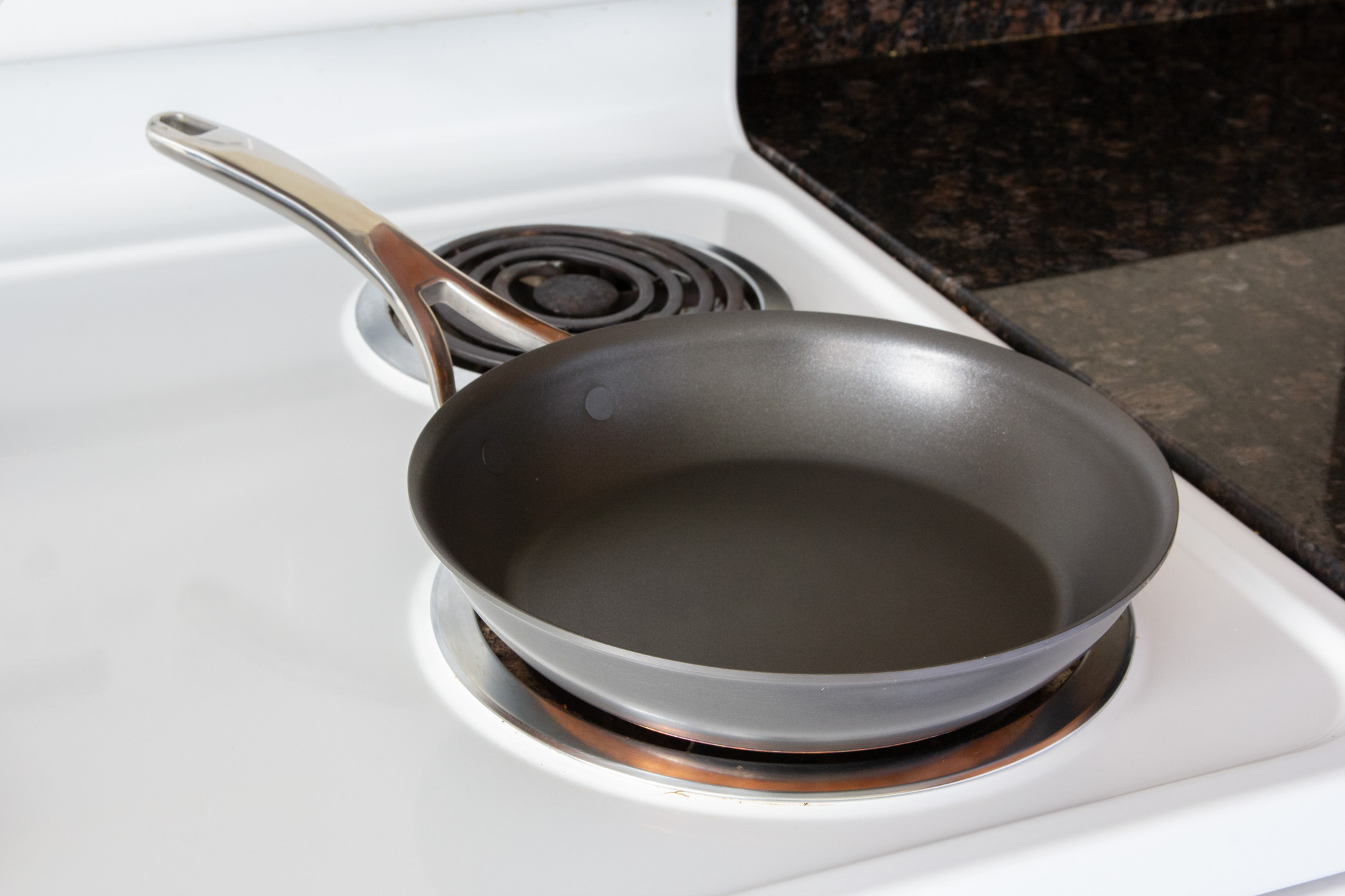
The Anolon – Nouvelle Copper cookware is for people who don’t want to invest in the real thing nor deal with copper’s fussy upkeep. The cookware has only a super-thin layer (0.6 millimeters) of copper sandwiched between anodized aluminum layers, but the skillets we tested did perform very similarly to our authentic copper pan.
The Anolon has some heft to it, thanks to the magnetic stainless steel base, which also makes the pans induction-friendly. The 10-inch skillet weighs in at almost 3 pounds, and the 8.5-inch skillet is lighter at 1 pound. The 10-inch skillet isn’t really suited to flipping flapjacks and omelettes, unless you’ve got wrist strength.
That quibble aside, the pans gave great results. The copper layer worked in conjunction with the aluminum layers to evenly distribute heat over the entire surface of the pan. The stainless-steel base prevented the pan from heating up as rapidly as the vintage copper, but once the pan was hot, it was easier to regulate its heat level.
Pancake batter poured in the center and sides of the pan cooked evenly at the same time, and when we turned the pancakes, they were golden brown with crispy ridges. Fried eggs stuck a little, but when we flipped and scrambled the yolks and uncooked whites, they released easily. The hamburger also browned evenly, and similar to the copper pan, when we pressed the burger to the sides of the pan, it continued to sizzle.
In our review of the best nonstick pan, we chose the Anolon – Advanced as the best because it was 100% nonstick during our tests. The Anolon – Nouvelle Copper is coated with Autograph 2 — Dupont’s high-end nonstick coating — but the manufacturer improved the pan’s overall design by recessing the handle-rivet heads on the inside, so they’re flat and also nonstick. The rivets in other nonstick pans are raised, and food particles get wedged between them, which we found annoying to remove.
Cleanup was a cinch; however, the attractive copper band on the pan’s base (a quarter-inch ring where the copper layer is exposed) needs to be routinely cleaned and polished, or it will stain and tarnish.
On the negative side, even with meticulous care, nonstick coating loses its effectiveness after two or three years of regular use, and the pans will need to be replaced. So, there’s no reason to spend a lot on any nonstick pan. The Anolon – Nouvelle Copper 10-inch and 8.5-inch skillets are sold as a set for only $46, which we think is a great price for an alternative to copper cookware.
Key takeaways:
- The well-priced Anolon – Nouvelle Copper is made of a copper layer sandwiched between durable anodized aluminum with a stainless-steel base, so it can be used on any cooktop, including induction.
- The pans we tested heated slower than the copper pan we tested, but once hot, heat was evenly distributed across the surface and sides of the pans.
- The Anolon – Nouvelle Copper has a high-end nonstick coating, which, unlike copper cookware, eventually loses its effectiveness, and the pans will need to be replaced.
Copper-infused ceramic-coated: Copper Chef
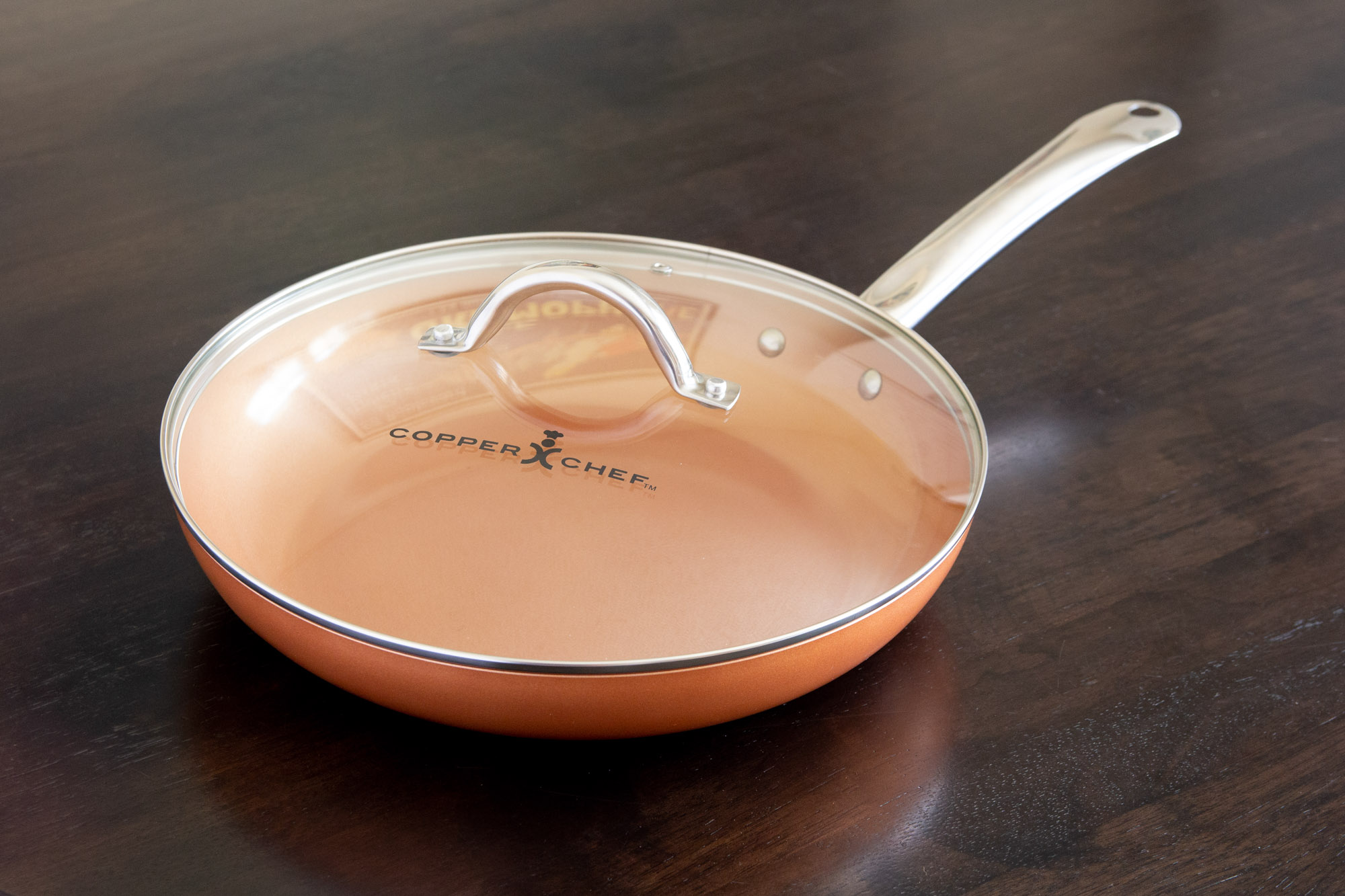
Copper Chef – KC15057-02000 copper-infused ceramic-coated pans are advertised as the only pans you’ll ever need for any cooking method. Don’t you believe it. There are hundreds of photos posted by dissatisfied consumers depicting their Copper Chef pans with burnt-on food that won’t wash off and pans blackened from high heat.
Copper Chef’s pans are made of very lightweight aluminum, and their interiors and exteriors are sprayed with a ceramic coating that purportedly contains copper. It’s impossible to find online how much copper infuses this coating, but our best guess is it’s negligible. According to advertising, the copper-infused coating will increase the pan’s conductivity as well as make it nonstick.
Testing proved otherwise. The pans have a thick aluminum disk on the bottom, which is supposed to distribute heat over the entire surface of the pan. It doesn’t. The bottom of the pan certainly gets hot, but no heat radiates past the circumference of the disk, leaving the sides of the pan cool. The hamburger cooked in the direct center of the pan, but when we moved it to any side, it steamed but didn’t brown.
The pan also has a convex surface that creates a gutter along the sides into which any liquid flows. Consequently, egg whites dribbled into the gutter, creating egg tendrils, and pancake batter pooled, producing oblong and unevenly cooked pancakes.
A major problem with marketing a pan as all-purpose is that high heat destroys nonstick coating, which should never be used for broiling meat or frying French fries. Copper Chef claims that their cookware can withstand temperatures up to 850°F. Since most ovens can only be set to 550°F, this marketing ploy is ridiculous. It comes as no surprise that so many consumers are enraged when food soon clings to their destroyed Copper Chef pan.
Fortunately, Copper Chef pans are pretty cheap, so if you want to try it out, buy a single pan instead of a set.
The bottom line
In our matchup between an authentic 100% copper pan, a copper-core pan and a copper-infused ceramic-coated pan, it was a tie between the real copper and the copper-core Anolon – Nouvelle Copper.
Copper is justifiably famous for its heat conductivity and distribution, and in our testing, the 100% copper pan cooked everything beautifully and quickly, even at medium-low heat. Cooking with copper, though, does take some getting used to, and copper cookware requires periodic maintenance to keep it shiny and the metal lining nonstick. It’s also extremely expensive, but it’s easy to find affordable vintage copper pieces, like we did, online.
The Anolon – Nouvelle Copper gave us similar results as the vintage copper pan. It didn’t heat up as fast, but when hot, heat was distributed over the surface and sides of the pan, and food was evenly cooked. The Anolon’s high-end nonstick coating was, for the most part, nonstick. Cleanup was easier with the Anolon, and for two skillets at $46, it’s well priced.
More Reviews
The 8 Best Electric Egg Cookers
Elite Gourmet - EGC-007B
The 8 Best Salt and Pepper Grinders
Merazi Living
Blue Apron
Martha & Marley Spoon
HelloFresh Meal Delivery Kit Review
HelloFresh
Lucky Jerky
NutriBullet Pro Review: Does it Perform?
Nutribullet - Pro 900
RTIC - 30-Ounce Tumbler


